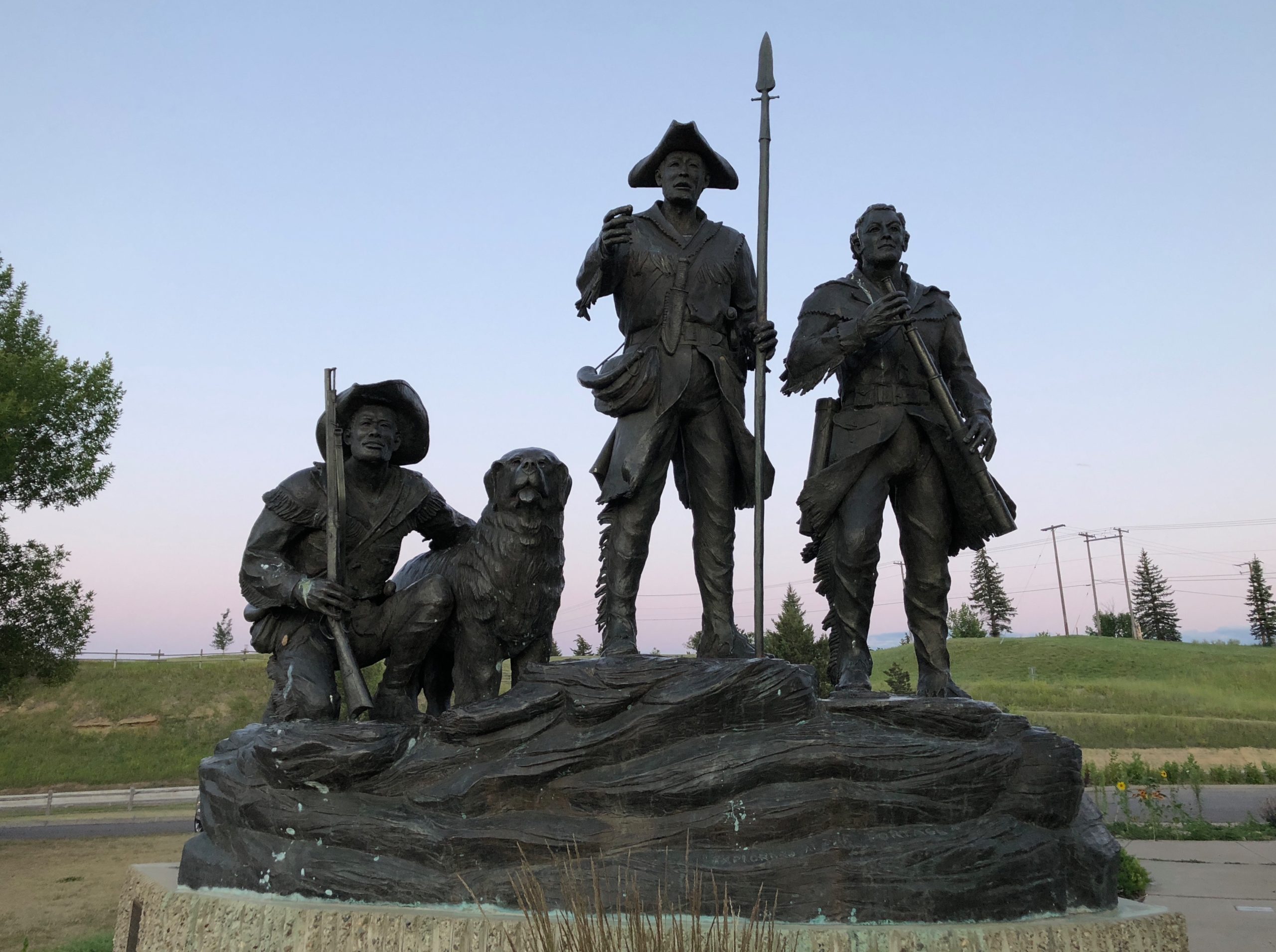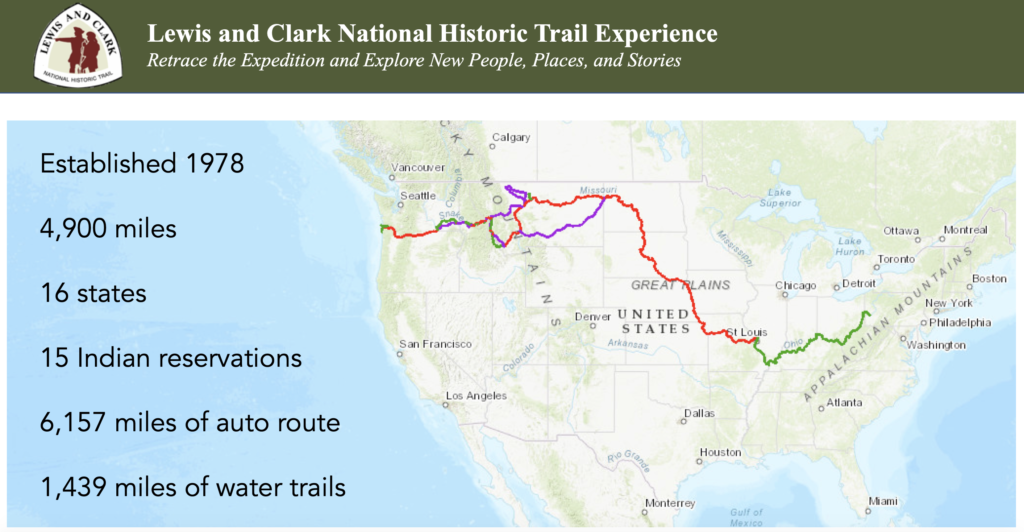
Why Did the Lewis and Clark National Historic Trail Need a Tourism Strategy
Most readers will recognize the National Park Service (NPS) as the preservers of natural and cultural resources in America’s most well-known protected lands, from Yellowstone and Acadia in the north to the Everglades and Grand Canyon National Parks in the southern portion of the US.
Most American’s may not realize, however, that NPS also acts as the stewards and protectors of the country’s numerous renowned trails, including the Appalachian Trail and the Pacific Coast Trail. One of the longest of these trails is the Lewis and Clark National Historic Trail that stretches 4,900 miles through 16 states, from Pittsburgh PA west to the Pacific Ocean in Oregon.
The Purpose of the Lewis and Clark National Historic Trail is to commemorate the 1803 to 1806 Lewis and Clark Expedition through the identification; protection; interpretation; public use and enjoyment; and preservation of historic, cultural, and natural resources associated with the expedition and its place in U.S. and tribal history. The LCNHT passes through hundreds of counties and thousands of communities as it traces the footprints of Meriwether Lewis and William Clark along America’s great rivers. Each of these towns and cities, no matter their size or population, has it an opportunity to become connected to the Trail as a means of not only preserving a critical piece of US culture and history, but also to bring forward economic gains.
This is where Solimar International enters into the story.
Note: Before moving forward into the details of why the Lewis and Clark National Historic Trail needed a tourism strategy, it should be noted that the National Park Service generally does not associate itself with tourism despite receiving millions of visitors each year. (NPS reported over 327 million recreation visits in 2019.) The leadership team for the LCNHT showed enhanced awareness in recognizing the importance leveraging the tourism industry to support residents and stakeholders along the trail.
The Need for a Strategy
Interconnectivity is vital to achieve sustainability in the tourism industry. This is true at all destination levels, whether it be in an individual city, county, state or nation. The Lewis and Clark National Historic Trial presented a unique set of opportunities in that it covers each of these four geographical (and political) points. Data suggests that over 3.1 million people visited at least one point along the Lewis and Clark Trail in 2017. These points include tribal museums, visitor centers and local/state/federal parks, not to mention the Trail’s countless hospitality enterprises. Despite a hugely eclectic group of stakeholders and millions of visitors, the LCNHT was lacking a common thread that allowed destinations and stakeholders to share a common identity.
A tourism strategy was necessary to unite the communities and individuals along the trail — all of whom have an underlying familiarity with the unique natural, cultural, historical and scenic assets of their destination – and provide a forum to build alliances. It was vital that the stakeholders acted as the storytellers for their individual community while still representing the mission and overstory of the Trail itself. This meant celebrating the character and culture of the destination while keening in on the overall sustainability of the trail. A strategy would have to be designed to allow these two forces operate in conjunction and in parallel with one another. Said another way, achieving sustainability successes along the trail would hinge on the celebration and preservation of a destinations’ culture and environment AND the trail would act as a catalyst for economic growth.
In this tourism strategy, the catalyst came in the form of Geotourism.
Geotourism Along The Lewis and Clark National Historic Trail


After discussion between NPS, Solimar, LCNHT partners and community leaders, it was determined that Geotourism would provide the framework for the most effective tourism strategy along the trail. Geotourism is defined as tourism that sustains or enhances the geographic character of a place, its environment, culture, aesthetics, heritage, and the well-being of its residents. It encompasses a range of travel including heritage, history, food, nature, adventure, the outdoors, water, music, and arts. iIn short, Geotourism celebrates any aspect of culture that makes a destination unique.
This strategy creates a link between the past and the present for communities along the trail, regardless of its place in history as it relates the Corps of Discovery. A small town in Western Iowa located on the banks of the Missouri River that is not mentioned in the Lewis and Clark journals may offer visitors phenomenal hiking trails or a brewery serving up beer made with hops from a farm across town. Ten minutes up-river and across the border in Nebraska, history buffs may find a plaque signifying camp site that the Corps of Discovery spent time hunting and fishing over 200 years ago. Bringing these two individual visitor experiences together onto one platform is a prime example of how Geotourism is being implemented along the Lewis and Clark National Historic Trail.
The Platform: Lewisandclark.travel
In addition to increased domestic and international awareness, Geotourism along the LCNHT lays the groundwork for an active community of public and private stakeholders working to conserve land and legacy. These linkages allow communities to connect with visitors that appreciate their authentic sense of place.
To bring these benefits to life, NPS and Solimar are working in conjunction to build a web platform where communities and stakeholders can write their own story and promote their brand. These stakeholders run the gamut of destination development and include:
- Locally owned and family businesses
- Events, ceremonies, and festivals
- Cultural experiences such as heritage sites, museums, theaters, music,
- Artist studios and galleries, craft workshops, and shops featuring handmade items
- Operators of outdoor experiences such as rafting, hiking, biking, hunting
- Historic sites such as trails, old homes, or places that features local architecture
- Scenic routes including hiking trails, bike routes, water ways, birding trails
- Local artist or artisan, storyteller, outdoor guide or historian
Any and all of these enterprises and sites are eligible to create an account and lewisandclark.travel and promote their own personalized page where they can write their own story through words and pictures. From a web-marketing perspective, these efforts will enhance the digital footprint of the business by creating linkages (backlinks) to the National Parks Service. Offline, participation in the program will assist local economies by bringing in more tourist dollars and increasing the tourism multiplier in communities along the trail.
Above all else, this tourism strategy for the Lewis and Clark National Historic Trail acts as a catalyst for community engagement and interaction along the trail. Bringing together an eclectic variety of different members from a city/town/county – government officials, restauranteurs, hoteliers, teachers, museum curators, historians, etc. – all with a common goal and shared visions in assisting the community at large. The tourism industry is in the midst of unprecedented times with the COVID-19 pandemic, and enhanced community relations via sustainable tourism is one of the key steps in coming out of this strong than ever.

